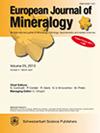Effect of oxygen fugacity on the storage of water in wadsleyite and olivine in H and H–C fluids and implications for melting atop the transition zone
IF 1.7
3区 地球科学
Q2 MINERALOGY
引用次数: 0
Abstract
Abstract. This study aims to experimentally constrain the water storage capacities of olivine and wadsleyite at a depth near 410 km (12–14 GPa) under water-saturated conditions, as a function of temperature, oxygen fugacity, and the presence of carbon (molar H / C of 2). Experiments have been conducted in the multi-anvil press, with sealed double capsules to preserve fluids, at 1200 to 1400 ∘C and three different oxygen fugacities fixed at the rhenium–rhenium oxide buffer (RRO), nickel–nickel oxide buffer (NNO), and iron-wüstite (IW) for oxidizing, intermediate, and reducing conditions, respectively. The water contents of minerals were measured by Raman spectroscopy that allows a very small beam size to be used and were cross-checked on a few samples with NanoSIMS analyses. We observe an effect, although slight, of fO2 on the water storage capacity of both wadsleyite and olivine and also on their solidus temperatures. At 1200 ∘C, the storage capacity of the nominally anhydrous minerals (NAMS) increases with increasing oxygen fugacity (from the IW to the RRO buffer) from 1 wt % to 1.5 wt % H2O in wadsleyite and from 0.1 wt % to 0.2 wt % in olivine, owing to the increase in H2O / H2 speciation in the fluid, whereas at 1400 ∘C the storage capacity decreases from 1 wt % to 0.75 wt % H2O in wadsleyite and down to 0.03 wt % for olivine. At high temperature, the water storage capacity is lowered due to melting, and the more oxidized the conditions are the more the solidus is depressed. Still, at 1400 ∘C and IW, wadsleyite can store substantial amounts of water: 0.8 wt % to 1 wt % H2O. The effect of carbon is to decrease water storage capacity in both wadsleyite and olivine by an average factor 2 at 1300–1400 ∘C. The trends in water storage as a function of fO2 and C presence are confirmed by NanoSIMS measurements. The solidus at IW without C is located between 1300 and 1400 ∘C in the wadsleyite stability field and drops to temperatures below 1300 ∘C in the olivine stability field. With the addition of C, the solidus is found between 1200 and 1300 ∘C in both olivine and wadsleyite stability fields.氧逸度对H和H - c流体中瓦德利石和橄榄石储水的影响及其对过渡带顶部熔融的影响
摘要这项研究的目的是通过实验来限制橄榄石和瓦氏滑石在410公里(12-14 GPa)深的水饱和条件下的储水能力,作为温度、氧逸度和碳(摩尔H / C为2)存在的函数。实验是在多顶压机上进行的,在1200到1400°C的情况下,用密封的双胶囊保存液体,将三种不同的氧逸度固定在氧化铼缓冲液(RRO)上。镍-镍氧化物缓冲液(NNO),氧化、中间和还原条件下的镍-镍缓冲液(IW)。矿物质的水分含量是通过拉曼光谱测量的,拉曼光谱允许使用非常小的光束尺寸,并通过NanoSIMS分析对一些样品进行交叉检查。我们观察到,尽管fO2对瓦德利石和橄榄石的储水能力以及它们的固相温度都有轻微的影响。1200∘C,名义上的存储容量anhydrousminerals(南)增加而增加氧气不安定(从信息战RRO缓冲区)从1 wt % 1.5 wt % H2O wadsleyite和0.1 wt % 0.2 wt %的橄榄石,由于增加了H2O / H2物种形成液体,而在存储容量减少1400∘C从wt % 0.75 wt % H2O wadsleyite和降至0.03 wt % forolivine。在高温下,储水能力因熔融而降低,氧化条件越强,固相越被抑制。然而,在1400°C和400°w的情况下,水蛭石仍能储存大量的水:0.8 wt %到1wt %的水。碳的作用是在1300-1400°C时,使长石和橄榄石的储水能力平均减少2倍。通过NanoSIMS测量证实了水储存随fO2和C存在的变化趋势。IW不含C的固形物在wadsleyite稳定场中处于1300到1400°C之间,在橄榄石稳定场中下降到1300°C以下。加上C后,在1200到1300°C之间的橄榄石和瓦德斯莱石稳定场中都可以找到经轴。
本文章由计算机程序翻译,如有差异,请以英文原文为准。
求助全文
约1分钟内获得全文
求助全文
来源期刊
CiteScore
2.80
自引率
9.50%
发文量
40
审稿时长
6-12 weeks
期刊介绍:
EJM was founded to reach a large audience on an international scale and also for achieving closer cooperation of European countries in the publication of scientific results. The founding societies have set themselves the task of publishing a journal of the highest standard open to all scientists performing mineralogical research in the widest sense of the term, all over the world. Contributions will therefore be published primarily in English.
EJM publishes original papers, review articles and letters dealing with the mineralogical sciences s.l., primarily mineralogy, petrology, geochemistry, crystallography and ore deposits, but also biomineralogy, environmental, applied and technical mineralogy. Nevertheless, papers in any related field, including cultural heritage, will be considered.

 求助内容:
求助内容: 应助结果提醒方式:
应助结果提醒方式:


